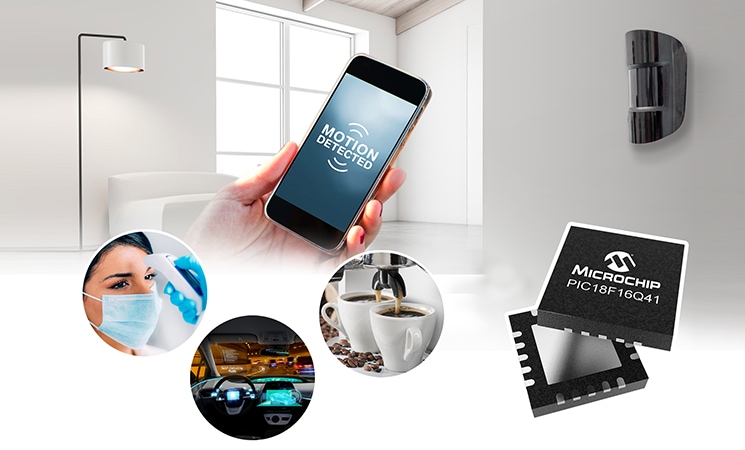Improve Sensor Interface Designs: The New PIC18-Q41 Product Family
Our PIC18-Q41 family addresses analog system design challenges and helps designers get to market quickly.

Sensor-based IoT designs depend on a combination of analog functionality and digital control capability to meet the list of requirements for small size, low cost, low power and overall performance. The PIC18-Q41 addresses these challenges with an increased microcontroller (MCU) integration of advanced analog and configurable peripherals with inter-peripheral connections for reduced signal acquisition time and reduced bill of materials (BOM). Its unified, seamless development tool environment also helps designers get to market quickly.
What’s Different About This New MCU Family?
Our new PIC18-Q41 product family is designed for compact, high performance data acquisition and sensor interfacing applications with an integrated operational amplifier and powerful Core Independent Peripherals (CIPs). For a comprehensive development tool experience, you can easily configure peripherals and functions, generate application code and simulate the operational amplifier circuit prior to hardware prototyping to reduce your development time and speed up your time to market. Available in compact 14- and 20-pin packages including the 3x3 mm VQFN, the MCUs are particularly well suited for IoT edge nodes, medical devices, wearables, LED lighting, home automation, the automotive industry and industrial process control. They also make an excellent companion to Microchip 32-bit MCUs and other controllers that need analog integration.
The PIC18-Q41 family integrates sophisticated analog peripherals for signal amplification, filtering and conditioning used in sensing and measurement applications. The MCUs are uniquely equipped with:
● 5.5 MHz Gain Bandwidth Operational Amplifier (OPA)
● Zero Cross Detect (ZCD)
● Comparators
● Two 8-bit Digital-to-Analog Converters (DACs)
● 12-bit Analog-to-Digital Converter with Computation (ADCC)
In addition, the ADCC automates Capacitive Voltage Divider (CVD) techniques for implementing advanced touch sensing, averaging, filtering, oversampling and automatic threshold comparison. The integration of these features significantly reduces the component count in the analog signal chain.
The family’s CIPs enable smaller, lower-power MCUs to accomplish many timing-critical and core-intensive tasks in hardware without any intervention from the CPU. This reduces the use of Flash memory and frees up the CPU to focus on more complex system tasks or go to sleep to save power. Because you don’t need to create any additional code or use any extra discrete components, they simplify your design while also reducing power consumption, allowing for deterministic response times and decreasing validation time.
The PIC18-Q41 MCUs are equipped with CIPs like Direct Memory Access (DMA), Configurable Logic Cells (CLCs), 16-bit PWMs and multiple communication interfaces. The CLC peripheral lets you specify combinations of signals as inputs to a logic function and internally connects peripherals such as timers, Pulse-Width Modulators (PWMs), serial ports and I/O pins for hardware customization with unprecedented ease. The CLC enables a higher level of integration without any external components, thus reducing PCB footprint and system costs. See the family’s block diagram in figure 1 for more information.
Get Started with Your Design
Build a protype quickly with our compact, cost-effective development board, the PIC18F16Q41 Curiosity Nano Evaluation kit, as seen in figure 2. The board has full programming and debugging capabilities with pre-programmed firmware so you can start development immediately. Getting started guides for a PIC® MCU provide easy-to-follow steps to start projects right away.
To reduce your time to market, the PIC18-Q41 family has been designed to integrate with MPLAB® Code Configurator (MCC) and MPLAB Mindi™ Analog Simulator for a seamless embedded development experience. MCC is a free, graphical programming environment that quickly generates application code. Using an intuitive interface, it enables and configures a rich set of peripherals and functions specific to your application. MCC is incorporated into our downloadable MPLAB X Integrated Development Environment (IDE). MPLAB Mindi Analog Simulator reduces circuit design time and design risk by simulating analog circuits prior to hardware prototyping. Code examples and analog simulations are also available to get a jump start on your development.
Check out the PIC18-Q41 family here for your next sensor interface design. You can purchase the PIC18-Q41 family of devices here, or from Microchip’s worldwide distribution network.